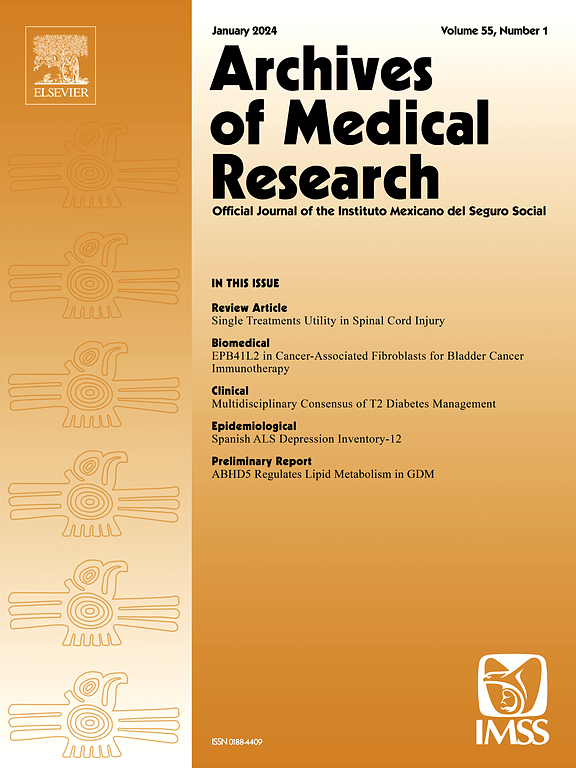墨西哥基于成本效益战略诊断冯-威廉氏病的十年经验。
IF 3.4
3区 医学
Q1 MEDICINE, RESEARCH & EXPERIMENTAL
引用次数: 0
摘要
背景:冯-威廉氏病(Von Willebrand disease,VWD)是全球最常见的遗传性出血性疾病,但在一些国家,其诊断复杂、昂贵且评估不足:方法:我们研究了 802 名墨西哥患者,其中包括男性、女性和儿童:我们对 802 名临床怀疑患有 VWD 的墨西哥男性、女性、儿童和成人患者进行了研究。进行了以下检查:血细胞计数、出血时间、凝血酶原时间、活化部分凝血活酶时间、纤维蛋白原浓度、VWF 抗原、利斯托西汀辅助因子活性、胶原蛋白结合试验、利斯托西汀诱导的血小板聚集、FVIII 活性和 VWF 多聚体分析:639名患者确诊为VWD,其中582人属于1型VWD(91.1%)。52 名患者(8.1%)发现了 2 型 VWD。2A型有25例(48.1%),2B型和2M型分别有21例(40.4%)和6例(11.5%)。3型VWD患者有5例(0.8%)。男性 VWD 患者的平均年龄为 25.3 岁(范围:2-71 岁),女性为 22.1 岁(范围:1-54 岁)。40例(5.0%)诊断结果不确定,123例(15.3%)诊断结果不确定。在 VWD 患者中,O 型血最为常见:我们采用低成本诊断策略证实,VWD 在墨西哥与其他国家一样常见。在怀疑有 VWD 的情况下,尽管实验室确诊可能比较困难且费用昂贵,但仍有必要对患者的病史进行审查。缺乏准确及时的诊断会影响治疗的及时性和质量。本文章由计算机程序翻译,如有差异,请以英文原文为准。
A ten-year experience with the diagnosis of von Willebrand disease in Mexico based on a cost-effective strategy
Background
Von Willebrand disease (VWD), is the most common inherited bleeding disorder worldwide, but its diagnosis is complicated, expensive, and poorly evaluated in several countries.
Objective
To report our long-term experience with the diagnosis of VWD based on a cost-effective strategy.
Methods
We studied 802 Mexican patients, men and women, children, and adults, with clinical suspicion of VWD. The following tests were performed: blood count, bleeding time, prothrombin time, activated partial thromboplastin time, fibrinogen concentration, VWF antigen, ristocetin cofactor activity, collagen binding assay, ristocetin-induced platelet aggregation, FVIII activity, and VWF multimers analysis.
Results
VWD was diagnosed in 639 patients; 582 had type 1 VWD (91.1%). Type 2 VWD was found in 52 patients (8.1%). Type 2A was present in 25 cases (48.1%), while types 2B and 2 M accounted for 21 (40.4) and six (11.5%) cases, respectively. Type 3 VWD was present in five patients (0.8%). The mean age of patients with VWD was 25.3 years (range: 2–71) for males and 22.1 (range: 1–54) for females. The diagnosis was inconclusive in 40 cases (5.0%) and was discarded in 123 (15.3%). Blood group O was the most common among patients with VWD.
Conclusion
Using a low-cost diagnostic strategy, we confirmed that VWD is as common in Mexico as in other countries. Review of the patient's history is mandatory when VWD is suspected, although laboratory confirmation may be difficult and expensive. The consequences of a lack of accurate and timely diagnosis affect the promptness and quality of treatment.
求助全文
通过发布文献求助,成功后即可免费获取论文全文。
去求助
来源期刊

Archives of Medical Research
医学-医学:研究与实验
CiteScore
12.50
自引率
0.00%
发文量
84
审稿时长
28 days
期刊介绍:
Archives of Medical Research serves as a platform for publishing original peer-reviewed medical research, aiming to bridge gaps created by medical specialization. The journal covers three main categories - biomedical, clinical, and epidemiological contributions, along with review articles and preliminary communications. With an international scope, it presents the study of diseases from diverse perspectives, offering the medical community original investigations ranging from molecular biology to clinical epidemiology in a single publication.
 求助内容:
求助内容: 应助结果提醒方式:
应助结果提醒方式:


